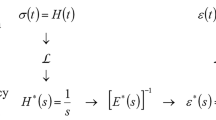Abstract
This study focuses on the use of P-wave propagation measurements in order to evaluate the complex modulus, more specifically for the reversible and dissipated parts of asphalt materials. Both the wave velocity and attenuation factor have been measured by means of an ultrasonic transmission test, at frequencies between 200 and 300 kHz and temperatures ranging from −20 to 40 °C. Based on this wave velocity and attenuation factor, the high-frequency complex modulus and its components are computed by considering a 2D propagation of waves in an isotropic viscoelastic medium. Results are plotted with respect to the master curve, Cole–Cole and Black spaces. The ultrasonic test results agree with results obtained by complex modulus test and then fitted by the 2S2P1D rheological model. This paper shows in Cole–Cole space that ultrasonic data can facilitate the determination of important rheological parameters as one of the two parabolic dashpots (k) and the glassy modulus E 0. The phase angle, which is also a key viscoelastic identification parameter, can be determined at high frequency in a Black space representation.








Similar content being viewed by others
References
In CW, Kim JY, Kurtis KE, Jacobs LJ (2009) Characterization of ultrasonic Rayleigh surface waves in asphaltic concrete. NDT&E Int 42:610–617
Rojas J, Nazarian S, Tandon V, Yuan D (1999) Quality management of asphalt-concrete layers using wave propagation techniques. Center for Highway Materials Research, University of Texas, Research Report 1735-2
Jiang ZY, Ponniah J, Casante G (2006) Improved Ultrasonic pulse velocity technique for bituminous material characterization. Annual Conference of the Transportation of Canada, Charlottetown, Canada, 17–20 September
Arabani M, Kheiry PT, Ferdosi B (2009) Laboratory evaluation of the effect of HMA mixt parameters on ultrasonics pulse wave velocities. Int J Road Mater Pavement Des 10:223–232
Tigdemir M, Kalyoncuoglu SF, Kalyoncuoglu UY (2004) Application of ultrasonic method in asphalt concrete testing for fatigue life estimation. NDT&E Int 37:597–602
Houel A, Arnaud L (2009) Damage characterization of asphalt in laboratory by ultrasonic wave propagation. Non Destructive Testing in Civil Engineering, June 30th–July 3rd, Nantes, France
Birgisson B, Roque R, Page GC (2003) Ultrasonic pulse wave velocity test for monitoring changes on Hot Mix Asphalt integrity from exposure to moisture. Transp Res Rec 1832:173–181
Tiwari V, Shukla A, Bose A (2004) Acoustic properties of cenosphere reinforced cement and asphalt concrete. Appl Acoust 65:263–275
Biligiri KP, Kaloush KE (2009) Prediction of pavement materials’ impedance using ultrasonic pulse velocity. Int. J. Road Mater Pavement Des 10:767–787
Mun S (2010) Sound absorption characteristics of porous asphalt concrete pavements. Can J Civ Eng 37:273–278
Dos Reis HLM, Habboub AK, Carpentier SH (1999) Nondestructive evaluation of complex moduli in asphalt concrete with an energy approach. Transp Res Rec 1681:170–178
Hochuli AS, Sayir MB, Poulikakos LD, Partl MN (2001) Measuring the complex modulus of asphalt mixtures by structural wave propagation. 26th Annual meeting of the association of asphalt paving cracking technologists AAPT, March 19–21, Clearwater Beach Florida, USA
Ryden N (2009) Determining the asphalt master curve from free-free resonant testing on cylindrical samples. Non Destructive Testing in Civil Engineering, June 30th–July 3rd, Nantes, France
Gudmarsson A, Ryden N, Birgisson B (2012) Application of resonant spectroscopy to asphalt concrete beams for determination of the dynamic modulus. Mater Struct 45:1903–1913
Mounier D, Di Benedetto H, Sauzéat C (2012) Determination of bituminous mixtures linear properties using ultrasonic wave propagation. Constr Build Mater 36:638–647
Barnes CL, Trottier JF (2009) Evaluating High-Frequency viscoelastic moduli in asphalt concrete. Res Nondestr Eval 20:116–130
Norambuena-Contreras J, Castro-Fresno D, Vega-Zamanillo A, Celaya M, Lombillo-Vozmediano I (2010) Dynamic modulus of asphalt mixture by ultrasonic direct test. NDT&E Int 43:629–634
Di Benedetto H, Sauzéat C, Sohm J (2009) Stiffness of bituminous mixtures using ultrasonic wave propagation. Int J Road Mater Pavement Des 10:789–814
Van Velsor JK, Premkumar L, Chehab G, Rose JL (2011) Measuring the complex modulus of asphalt concrete using ultrasonic testing. J Eng Sci Technol Rev 4:160–168
Olard F, Di Benedetto H (2003) General 2S2P1D model and relation between the linear viscoelastic behaviours of bituminous binders and mixes. Road Mater Pavement Des 4:1985–2224
Di Benedetto H, Partl MN, Franckeen L, La Roche De, Saint André C (2001) Stiffness testing for bituminous mixtures. Mater Struct 34:66–70
Di Benedetto H, Corté JF (2005) Matériaux routiers bitumineux 2. Hermès Lavoisier editions
Chailleux E, Ramond G, Such C, de la Roche C (2006) A mathematical-based master-curve construction method applied to complex modulus of bituminous materials. Road Mater Pavement Des, EATA 2006:75–92
Zinszner B, Bourbié T, Coussy O (1967) Acoustique des milieux poreux. Editions Technip, Paris
Hendee WR, Ritenour ER (2002) Medical imaging physics. Editions Wiley-Lies inc, New York
Le Huérou JY, Gindre M, Amarene A, Urbach W, Waks M (2003) Compressibility of nano inclusions in complex fluids by ultrasound velocity measurements. IEEE Trans Ultrason Ferroelectr Freq Control 50:1595–1600
Peters F, Petit L (2003) A broad band spectroscopy method for ultrasound wave velocity and attenuation measurement in dispersive media. Ultrasonics 41:357–363
Jiang ZY, Ponniah J, Cascante G. (2008) Field condition assessment of longitudinal joints in asphalt pavements using seismic wave technology. Annual Conference of the transportation Association of Canada Toronto, September 21–24, Ontario
Graziani A, Bocci M, Canestrari F (2013) Complex Poisson’s ratio of bituminous mixtures: measurement and modeling. Mater Struct. doi:10.1617/s11527-013-0117-2
Author information
Authors and Affiliations
Corresponding author
Rights and permissions
About this article
Cite this article
Larcher, N., Takarli, M., Angellier, N. et al. Towards a viscoelastic mechanical characterization of asphalt materials by ultrasonic measurements. Mater Struct 48, 1377–1388 (2015). https://doi.org/10.1617/s11527-013-0240-0
Received:
Accepted:
Published:
Issue Date:
DOI: https://doi.org/10.1617/s11527-013-0240-0




